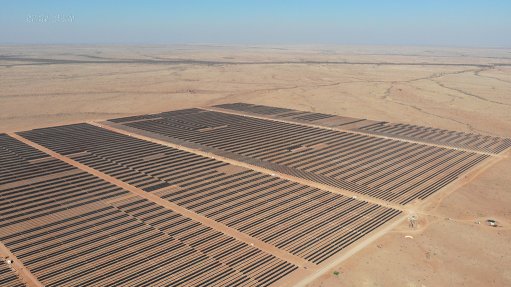2013 productivity stats reveal mixed sector performances
South Africa’s gross domestic product growth rate slowed to 1.9% in 2013, compared with 2.5% in 2012, the 2013 Productivity Statistics report revealed on Tuesday.
Compiled by schedule 3A public entity Productivity SA the report, presented in Midrand, was aimed at enabling key stakeholders, including government, business and labour, to scrutinise the performance of the South African economy.
The agriculture, forestry and fishery sector saw an increase in the real output growth rate of 2.2%. The increase occurred despite a 6.8% decrease in the labour productivity growth rate in 2013.
Productivity SA chief economist Keneuoe Mosoang noted that a few sectors of the economy performed well, including the mining sector, which achieved a growth rate of 3.1% in 2013 from -3.6% in 2012.
However, the positive growth rate in output was not accompanied by an increase in labour input in the mining sector, which experienced a decline of -3.1% in 2013.
The Department of Labour Deputy Minister Nkosi Phathekile Holomisa said the relationship between the productivity indicators in the mining sector highlighted that for the sector to improve its real output, additional labour was required, meaning that the sector had operated below its optimal efficiency in 2013.
It was an area that needed to be improved on as a matter of urgency, he said.
Other sectors that suffered included the electricity, gas and water sectors.
The situation was underlined by the decline in the rate of capital, labour and multifactor productivity indicators, which were -9.4%, -0.6% and -6.5% respectively.
“Further, the relatively lower growth in compensation of employees in 2013 compared with 2012 in relation to labour input growth, suggests that there was a reduction in the number of highly-paid employees. This further suggests that the unit labour costs should not be taken at face value, but rather an investigation of the changes in the composition of labour between skilled and semiskilled should be taken into account. This is yet another area that must be attended to, urgently,” Holomisa stated.
Meanwhile, a decline in the manufacturing sector’s real output growth rate was mainly owing to a decrease in multifactor productivity in 2013 where both labour and capital share declined. The Deputy Minister noted that this indicated a contraction of the sector despite interventions by government.
Based on productivity indicators, the growth rate in the real output of the construction sector in 2012 and 2013 was supported by the improved growth rates of labour and multifactor productivity.
Another key factor for consideration was the improvement in the use of capital in the sector. The positive impact on real output growth of the increased capital use in the secondary sector – comprising manufacturing, electricity, gas, water and construction – was only realised in the construction industry.
Steady improvement in this area would add to productive gains for the future, said Holomisa.
The growth rate of real output in the wholesale, retail, trade, catering and accommodation sector was owing to an increase in capital, labour and multifactor productivity in 2013.
“However, what is important is to note that the 2013 productivity growth rates were lower than those of 2012, suggesting a contraction in the growth of the [wholesale, retail, trade, catering and accommodation] sector. This is another area that requires our attention.
“The slower positive growth in real output in 2013 of the transport, storage and communication sector was supported by a strong growth rate in labour productivity despite declining capital and multifactor productivity rates. There is also room for improvement in this area,” Holomisa commented.
Meanwhile, the continued growth in the real output of the finance, insurance, real estate and business services sector in 2013 was stimulated by the growth rates in labour, capital and multifactor productivity and supported by growth in capital use.
The Deputy Minister noted that this area was a source of encouragement and inspired continuous improvement.
PRODUCTIVITY MONTH
Productivity SA CEO Bongani Coka declared October Productivity Month with this year’s theme being “productivity is everybody’s business”.
Productivity Month is aimed at generating awareness about the importance of improved productivity in all facets and to solicit buy-in from the private sector, government and the public at large.
“October is a month in which we try and increase every effort to inspire a competitive and productive South Africa. Government has a critical role to play in raising awareness about productivity among its people and industry, and nurturing their positive attitude toward productivity improvement.
“The effectiveness and sustainability of a productivity movement depends on the extent to which government commits itself to the movement, in particular by availing sufficient funding on a regular basis,” Coka highlighted.
Holomisa stated that the broader objectives of Productivity Month were to promote productivity in the South African industry, raise awareness of the potential role of productivity in growing and developing the economy, promote Productivity SA’s programmes and the solutions to assist ailing companies, and increase South Africa’s competitiveness.
Employers and managers were encouraged to set up enterprise productivity improvement programmes supported by different gain sharing systems, participate in strategy development, promote labour-management cooperation in national productivity organisations and contribute to assessing the business environment and creating a participative work environment.
Comments
Announcements
What's On
Subscribe to improve your user experience...
Option 1 (equivalent of R125 a month):
Receive a weekly copy of Creamer Media's Engineering News & Mining Weekly magazine
(print copy for those in South Africa and e-magazine for those outside of South Africa)
Receive daily email newsletters
Access to full search results
Access archive of magazine back copies
Access to Projects in Progress
Access to ONE Research Report of your choice in PDF format
Option 2 (equivalent of R375 a month):
All benefits from Option 1
PLUS
Access to Creamer Media's Research Channel Africa for ALL Research Reports, in PDF format, on various industrial and mining sectors
including Electricity; Water; Energy Transition; Hydrogen; Roads, Rail and Ports; Coal; Gold; Platinum; Battery Metals; etc.
Already a subscriber?
Forgotten your password?
Receive weekly copy of Creamer Media's Engineering News & Mining Weekly magazine (print copy for those in South Africa and e-magazine for those outside of South Africa)
➕
Recieve daily email newsletters
➕
Access to full search results
➕
Access archive of magazine back copies
➕
Access to Projects in Progress
➕
Access to ONE Research Report of your choice in PDF format
RESEARCH CHANNEL AFRICA
R4500 (equivalent of R375 a month)
SUBSCRIBEAll benefits from Option 1
➕
Access to Creamer Media's Research Channel Africa for ALL Research Reports on various industrial and mining sectors, in PDF format, including on:
Electricity
➕
Water
➕
Energy Transition
➕
Hydrogen
➕
Roads, Rail and Ports
➕
Coal
➕
Gold
➕
Platinum
➕
Battery Metals
➕
etc.
Receive all benefits from Option 1 or Option 2 delivered to numerous people at your company
➕
Multiple User names and Passwords for simultaneous log-ins
➕
Intranet integration access to all in your organisation





















